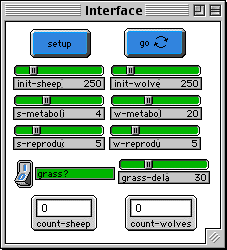
WHAT IS IT? ----------- This model explores the stability of predator-prey ecosystems. Such systems are called unstable when they tend to result in extinction for one or more species involved. In contrast, systems are stable when they tend to maintain themselves over time, despite fluctuations in population sizes. There are two main variations to this model. In the first variation, wolves and sheep wonder randomly around the landscape, while the wolves look for sheep to prey on. Each step costs the wolves energy, and they must eat sheep in order to replenish their energy - when they run out of energy they die. To allow the population to continue, each wolf or sheep has a fixed probability of reproducing at each time step. This variation produces interesting population dynamics, but is ultimately unstable. The second variation includes grass (green) in addition to wolves and sheep. The behavior of the wolves is identical to the first variation, however this time the sheep must eat grass in order to maintain their energy - when they run out of energy they die. Once grass is eaten it will only regrow after a fixed amount of time. This variation is more complex than the first, but it is generally stable. This model is described in greater detail in: Wilensky, U. & Reisman, K. (forthcoming). Thinking like a Wolf, a Sheep or a Firefly: Learning Biology through Constructing and Testing Computational Theories -- an Embodied Modeling Approach. http://www.ccl.tufts.edu/cm/papers/bio/bio-long.html and in Wilensky, U. & Reisman, K. (1998). Learning Biology through Constructing and Testing Computational Theories -- an Embodied Modeling Approach. In Y. Bar-Yam (Ed.), Proceedings of the Second International Conference on Complex Systems. Nashua, NH: New England Complex Systems Institute. http://www.ccl.tufts.edu/cm/papers/bio/bio-short.html HOW TO USE IT ------------- 1. Set the GRASS? switch to I to include grass in the model, or to O to only include wolves (red) and sheep (white). 2. Adjust the slider parameters (see below), or use the default settings. 3. Press the SETUP button. 4. Press the GO button to begin the simulation. 5. View the POPULATION SIZES plot to watch the populations fluctuate over time 6. View the count-sheep/count-wolves monitors to view current population sizes Parameters: INIT-SHEEP: The initial size of sheep population INIT-WOLVES: The initial size of wolf population S-METABOLISM: The amount of energy sheep get for every grass patch eaten W-METABOLISM: The amount of energy wolves get for every sheep eaten S-REPRODUCTION: The probability of a sheep reproducing at each time step W-REPRODUCTION: The probability of a wolf reproducing at each time step GRASS-DELAY: How long it takes for grass to regrow once it is eaten GRASS?: Whether or not to include grass in the model - note that sheep do not deduct energy for their movements when grass is not included Notes: - one unit of energy is deducted for every step a wolf takes - when grass is included, one unit of energy is deducted for every step a sheep takes THINGS TO NOTICE ---------------- When grass is not included, watch as the sheep and wolf populations fluctuate. Notice that increases and decreases in the sizes of each population are related. In what way are they related? What eventually happens? Once grass is added, notice the green line added to the population plot representing fluctuations in the amount of grass. How do the sizes of the three populations appear to relate now? What is the explanation for this? Why do you suppose that some variations of the model might be stable while others are not? THINGS TO TRY ------------- - Try adjusting the parameters under various settings. How sensitive is the stability of the model to the particular parameters? - Can you find any parameters that generate a stable ecosystem that includes only wolves and sheep? - Try setting GRASS? to I, but setting INIT-WOLVES to 0. This gives a stable ecosystem with only sheep and grass. Why might this be stable while the variation with only sheep and wolves is not? - Notice that under stable settings, the populations tend to fluctuation at a predictable pace. Can you find any parameters that will speed this up or slow it down? EXTENDING THE MODEL ------------------- - There are a number ways to alter the model so that it will be stable with only wolves and sheep. Some will require new elements to be coded in or existing behaviors to be changed. Can you develop such a version? STARLOGOT FEATURES ------------------- REFERENCES ---------- Wilensky, U. & Reisman, K. (forthcoming). Thinking like a Wolf, a Sheep or a Firefly: Learning Biology through Constructing and Testing Computational Theories -- an Embodied Modeling Approach. http://www.ccl.tufts.edu/cm/papers/bio/bio-long.html Wilensky, U. & Reisman, K. (1998). Learning Biology through Constructing and Testing Computational Theories -- an Embodied Modeling Approach. In Y. Bar-Yam (Ed.), Proceedings of the Second International Conference on Complex Systems. Nashua, NH: New England Complex Systems Institute. http://www.ccl.tufts.edu/cm/papers/bio/bio-short.html